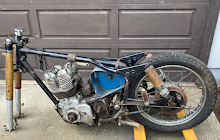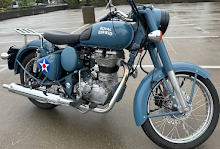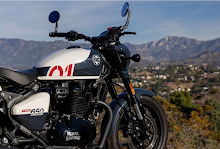 |
| Nadine De Freitas set a land speed record with the Royal Enfield Continental GT. |
The Continental GT she rode was prepared by Matt Capri of South Bay Triumph in Lomita, Calif. He has developed an "anti-vibration kit" for it that will be available to the public, De Freitas told me.
That's just one example of the go-faster bits on their way, she said. She and boyfriend Paul Runion — an ace race bike tuner himself — plan to market some of these through their Speyside Enterprises performance services business.
The Continental GT can go faster, she said.
"I went 98. It will go a hundred," she said with a verbal shrug I could hear over the phone.
She described the challenges of Bonneville for me. Her Royal Enfield runs were her third time on the salt and she has much gone faster there — see the video here — on Triumph motorcycles.
But pure speed isn't the point, De Freitas explained. The Continental GT can be competitive in its class. The point is to set a record in that class. The Continental GT she rode was 500cc (instead of the stock 535cc) to keep it from having to compete against larger motors in the next class up the ladder.
The Salt Flats do all they can to make it difficult. If there's a crash and one of the two ambulances has to leave, racing ends. De Freitas recalled driving to the track through six inches of water and waiting hours in line from dawn to 3 p.m. to make a run only to have the track shut down for the day because of an approaching thunderstorm.
"That's what Paul calls 'Land Speed Waiting.'"
Some competitors don't realize what they're up against. Not everyone expects the variation in barometric pressure that comes with 4,200 feet of altitude and temperature changes.
"You bring a bike from Florida..."
On top of that, there's the salt. If it's dry, it's cracked and rough. If it's wet it's slippery. Track lengths for getting up to speed and slowing down can vary — by miles — from year to year, depending on conditions.
"It's not scary to go fast in a straight line. On the salt there are only two things I worry about," De Freitas said.
"The first is traction. You see people with plenty of power and the wheel just spins; it's not doing any good. The second is a tank slapper. None of the bikes I've ridden have had that instability."
I pushed her on the question of fear. Does a rider at Bonneville just "go for it and hang on?" I asked.
Nah.
De Freitas described the runs as far more complicated, a critical matter of watching the flag markers while getting up to speed, being timed and then slowing down. Organizers used to lay a colored center line down the course but don't anymore because of environmental concerns. So just staying on the course (which is the only salt that has been scrapped smooth enough to be safe) is a concern.
 |
| Nadine De Freitas with stock Royal Enfield Continental GT. |
"I really enyojed riding the stock GT today. The lower gears provide plenty of torque, without having to rev the engine excessively... The ergonomics are perfect for me with only a slight forward lean. Even though the seat height is 31.4 inches, and I am 5-foot 2-inches, I had no problem feeling stable when stationary on the GT.
"This bike is a 535ccs and the bikes I rode on the salt were 500cc since the class restriction was 500ccs. This may explain why the power felt similar. The bike responds well to the slightest input to so that just shifting weight on the handlebars makes the bike turn easily. The Keihin electronic fuel injection makes the bike run very smoothly when you roll the throttle open without any hesitation or missing."
She'll be taking the Continental GT and a GoPro camera to the Smokey Mountains soon.
She promised to share the videos.
Nadine De Freitas lives in Titusville, Fla. A native of Trinidad, she galloped horses for her father, trainer and former champion jockey Ed De Freitas, and "did a lot of show jumping since we had a riding school on the farm."
Her mother lost the argument against having a motorcycle when Nadine was between undergraduate and grad school. She is now a physical therapist and athletic trainer with a doctorate in physical therapy.

























No comments:
Post a Comment